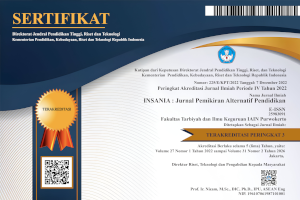Model “The Best Procces†Pendidikan Bermutu dan Berdaya Saing
Model “The Best Procces†Pendidikan Bermutu dan Berdaya Saing
DOI:
https://doi.org/10.24090/insania.v22i2.1205Keywords:
model, process, quality, competitiveAbstract
The rationale of this article is based on the quality of the school and the quality of the graduates is still low, the implementation of sentaralistic education, the school management is not appropriate, the input-output analisys approach, the community participation is still weak, and cooperation is still low. Then the required management model that can create a quality education and competitive. Model "The Best Procces" quality education and competitiveness can be one solution in creating quality education and competitive. This model aims to create high quality schools and graduates, namely schools that prioritize good planning, implementation, and evaluation processes, supported by management that has the character of improving students' cognitive, affective, psychomotoric, believing skills, and operational skills, leadership skills skills.Downloads
References
Arikunto, Suharsimi. 2009. Prosedur Penelitian Suatu Pendekatan Praktik. Jakarta: Bina Aksara.
Danim, Sudarwan. 2006. Visi Baru Manajemen Sekolah: Dari Unit Birokrasi ke Lembaga Akademik. Jakarta: Bumi Aksara.
Hadis, Abdul, dkk. 2010. Manajemen Mutu Pendidikan. Jakarta: Alfabeta.
Mulyasana‚ Dedi. 2012. Pendidikan Bermutu dan Berdaya Saing. Yogyakarta: PT. Remaja Rosdakarya.
Sagala, Sy. 2006. Manajemen Strategic dalam Peningkatan Mutu Pendidikan. Bandung: Alfabeta.
Sallis, Edward. 1993. Total Qualiti Management in Education. London: Kogan.
Sanusi, Achmad. 2015. Sistem Nilai. Bandung: Nuansa Cendikia.
__________________. 2015. Pendidikan untuk Kearifan, Bandung: Nuansa Cendikia.
Undang-undang nomor 23 tahun 2003 tentang Sistem Pendidikan Nasional.
Downloads
Published
How to Cite
Issue
Section
License
Authors who publish with this journal agree to the following terms:
Authors retain copyright and grant the journal right of first publication with the work simultaneously licensed under a Creative CommonsAttribution-ShareAlike License that allows others to share the work with an acknowledgment of the work's authorship and initial publication in this journal.
Authors are able to enter into separate, additional contractual arrangements for the non-exclusive distribution of the journal's published version of the work (e.g., post it to an institutional repository or publish it in a book), with an acknowledgment of its initial publication in this journal.
Authors are permitted and encouraged to post their work online (e.g., in institutional repositories or on their website) prior to and during the submission process, as it can lead to productive exchanges, as well as earlier and greater citation of published work (See The Effect of Open Access).








